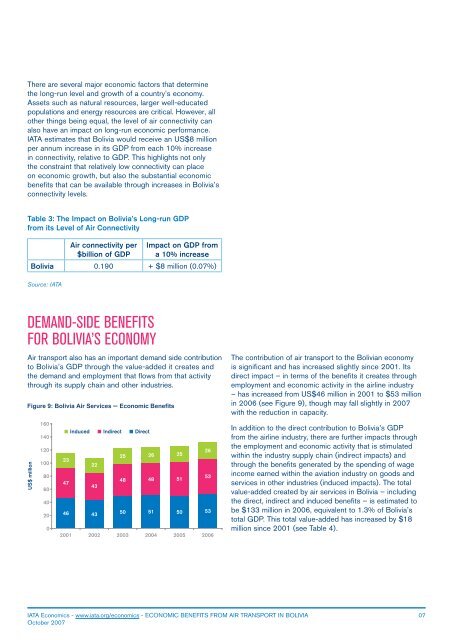ECONOMIC BENEFITS FROM AIR TRANSPORT IN BOLIVIA - IATA
ECONOMIC BENEFITS FROM AIR TRANSPORT IN BOLIVIA - IATA
ECONOMIC BENEFITS FROM AIR TRANSPORT IN BOLIVIA - IATA
You also want an ePaper? Increase the reach of your titles
YUMPU automatically turns print PDFs into web optimized ePapers that Google loves.
There are several major economic factors that determine<br />
the long-run level and growth of a country’s economy.<br />
Assets such as natural resources, larger well-educated<br />
populations and energy resources are critical. However, all<br />
other things being equal, the level of air connectivity can<br />
also have an impact on long-run economic performance.<br />
<strong>IATA</strong> estimates that Bolivia would receive an US$8 million<br />
per annum increase in its GDP from each 10% increase<br />
in connectivity, relative to GDP. This highlights not only<br />
the constraint that relatively low connectivity can place<br />
on economic growth, but also the substantial economic<br />
benefits that can be available through increases in Bolivia’s<br />
connectivity levels.<br />
Table 3: The Impact on Bolivia’s Long-run GDP<br />
from its Level of Air Connectivity<br />
Air connectivity per<br />
$billion of GDP<br />
Impact on GDP from<br />
a 10% increase<br />
Bolivia 0.190 + $8 million (0.07%)<br />
Source: <strong>IATA</strong><br />
DEMAND-SIDE <strong>BENEFITS</strong><br />
FOR <strong>BOLIVIA</strong>’S ECONOMY<br />
Air transport also has an important demand side contribution<br />
to Bolivia’s GDP through the value-added it creates and<br />
the demand and employment that flows from that activity<br />
through its supply chain and other industries.<br />
The contribution of air transport to the Bolivian economy<br />
is significant and has increased slightly since 2001. Its<br />
direct impact – in terms of the benefits it creates through<br />
employment and economic activity in the airline industry<br />
– has increased from US$46 million in 2001 to $53 million<br />
in 2006 (see Figure 9), though may fall slightly in 2007<br />
with the reduction in capacity.<br />
In addition to the direct contribution to Bolivia’s GDP<br />
from the airline industry, there are further impacts through<br />
the employment and economic activity that is stimulated<br />
within the industry supply chain (indirect impacts) and<br />
through the benefits generated by the spending of wage<br />
income earned within the aviation industry on goods and<br />
services in other industries (induced impacts). The total<br />
value-added created by air services in Bolivia – including<br />
the direct, indirect and induced benefits – is estimated to<br />
be $133 million in 2006, equivalent to 1.3% of Bolivia’s<br />
total GDP. This total value-added has increased by $18<br />
million since 2001 (see Table 4).<br />
<strong>IATA</strong> Economics - www.iata.org/economics - <strong>ECONOMIC</strong> <strong>BENEFITS</strong> <strong>FROM</strong> <strong>AIR</strong> <strong>TRANSPORT</strong> <strong>IN</strong> <strong>BOLIVIA</strong><br />
October 2007<br />
07
















